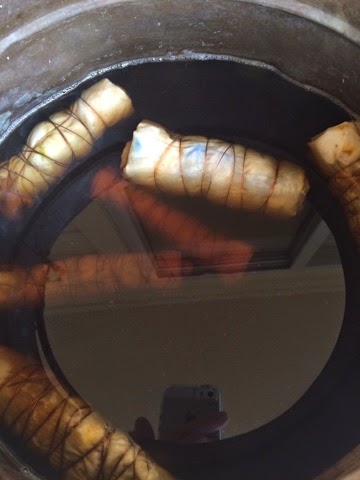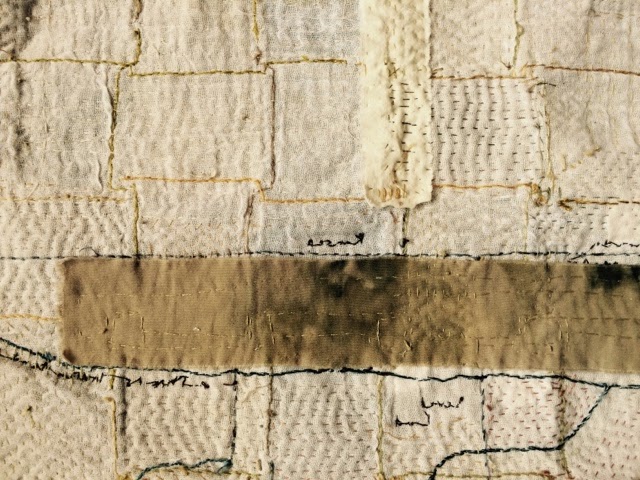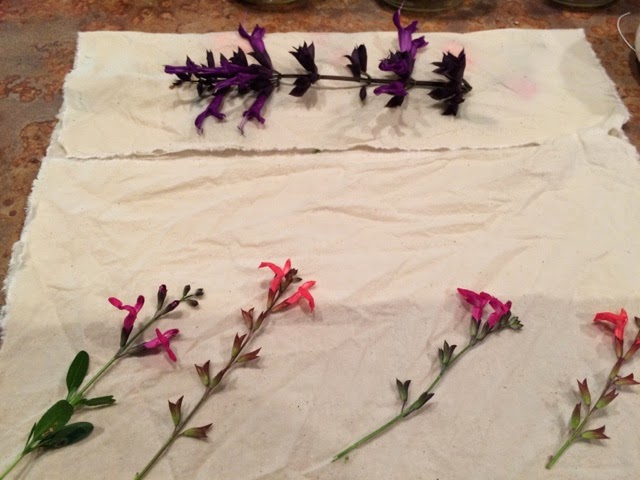Well, I’m trying dyeing again, inspired by India Flint’s Bundle Book (which I bought in digital form) …
this time using 14″ squares of unbleached cotton muslin soaked in store-bought soy milk (I blush), dried overnight, rinsed and spun through the washer until just damp.
I laid various dyestuffs (listed below) across the middle of each muslin square …
folded over one-third of the muslin and laid out a second layer of material …
 |
folded it over yet again ..
The dyestuffs I’m using this time are fresh rosemary (shown above), dried red and yellow onion skins (combined), chopped red cabbage, windfall lichen (Parmotrema austrosinense), mealy blue sage (wild Salvia farinacea) …
and a combination of cultivated Salvia amistad and S. greggi from Don’s garden beds …
I made three packets of each dyestuff, then wrapped them in either copper wire, steel wire or crochet cotton.
The copper wire bundles went into a copper pot with untreated well water from our outdoor tap. The smell of sulfur from our 900′ well is unbelievable and I’m hoping there will be a chemical reaction with the copper. After simmering the bundles for just over an hour some blue is starting to show …
 |
After a couple of hours, I’ll put the copper bundles and the sulfur-rich steeping water into canning jars with used tea bags and seal them up.
The steel wire wrapped bundles have already been put into canning jars with boiling tap water, used tea bags and fine steel wool. However, after one hour the color got so dark (see below right) that I chickened out and removed the steel wool (leaving a small bit behind, no doubt).
Finally, the cotton wrapped bundles were put into a solution of boiling tap water and pickling alum (1 tsp. per canning jar) along with the obligatory tea bags, which are also starting to show color (below left) …
 |
Now the question is, can I keep my hands off of the dye trials for at least a week?
Fortunately, I have a plan. Having finished the kantha stitching on Triangulation …
I’m now “design mending” (a Jude Hill term) by invisibly basting strips of cloth onto the back along the intersections since the original cloth weaving strips don’t meet closely enough …
 |
| I started design mending with dyed sheeting, then decided to switch over to muslin for the remainder |
It’s gonna take a while …
 |
| The bottom shows a 1″ strip of muslin invisibly basted across the length of the cloth which will be the method used for the remainder of the design mending |
But my reward for finishing will be the dye trial reveal. Motivation times two!









Wow Liz…Love the kantha piece..very inspiring! Looking forward to seeing what happens with you dye trials. I think I'd also have a hard time not peeking!
LikeLike
Well, I've had disappointing results when I rush things (my cochineal trials are a good example). So for all the effort, it's worth waiting. But I know myself well enough to have some added incentive.Thanks for coming by …
LikeLike
Posted a comment last night but have a feeling it went off into cyberspace: Looking at all of these \”gifts waiting to be unwrapped\” has a big ole smile on my face cause you dear Liz are becoming a dye alchemist. It will be terrific to see the results of all of this but not until at least 7 days says this old dyer who sometimes unbundles after 24 hrs!! Looking forward especially to seeing if the double mordant gives more intense color and markings because I've never used soy milk and alum on the same piece of cloth; usually I use one or the other or rely on my pot or some of my materials (walnuts, tea) to give the color grab possibility.From my own experiments using rosemary, didn't get any color but the cloth smelled wonderful; you will at least get tea color. Fearless experimenting is the true joy of the process for me and I see dear \”cauldron\” sister that you are on the same path; usually I never get the same results twice and to me, that is the magic of it all. Yes re the steel wool – My first experiments yielded the same results, splotches of dark so over time, I just peeled off strands of steel wool much like peeling off a single strand of embroidery thread and wound it over and under and around my dye materials. Resulted in veiny looking markings that add a lot of depth to cloth.Red onion skins work magic when doused with vinegar and put in a copper pot because they give that most elusive natural dye color, green. I've also gotten green by tearing pieces of red onion, placing them on cloth, splashing with vinegar, again placing in a copper pot for a day then putting them into glass jars. And I'm noting your glass jar experimenting with great interest because I don't often fill my jars with liquid, I usually put my bundles in my cauldron of choice, heat for a time, let sit in the liquid for a time then place the wet bundles into the glass jars and let the sun do magic..What I love about this process of dyeing is the sharing that goes on between all of us cauldron sisters; that is also the side gift of naturally dyeing cloth so thanks for all of your experimenting Liz.
LikeLike
I am moderating comments these days to head off spam … that being said, this was the only comment in my in-box, so Blogger must've eaten the other one. Makes me sad to think of your well-chosen words vaporizing.In any case, I did look back at our previous correspondence to see if you had any words of wisdom vis-a-vis (ugh, spell check just went nuts) mordanting with soy milk. Wish I had noted your onion/vinegar recommendation while I was at it. But there will be other trials, for sure!Thanks, as always, for your wonderful comments.
LikeLike
Re soy milk mordanting: in the beginning I poured it full strength over my cloths, left them to soak for several days, wrung them out, line dried them and they were stiffer than a board. Now I dilute the soy milk with a little water, leave only for 24 hrs, line dry then rewet and let them dry indoors on my clothes rack and they are good to go.
LikeLike
thanks for sharing the details of your experiments and Triangulation looks amazing, what a journey (but will say I liked it more with less of the kantha stitching but that's just my personal taste asI am not a fan of running stitch)
LikeLike
Well, I have to admit that all that kantha wasn't in the original plan … it was a necessity after I failed to place the cloth weaving strips close enough together, which was compounded by not putting in enough invisible baste. Live and learn. While I do like the feel of the kantha, it does obscure detailed stitching. I loved your idea of differentiating the open southwest with the cultivated Midwest … maybe next time when I make a companion pillow.
LikeLike
Ha! You're right about the stiffening effect of undiluted soy milk! Good to know this alternative (next time I'll ask you first … ha!)
LikeLike
I am so looking forward to the unbundling of your dye experiments. Thank you for sharing the process. Triangulation is just wonderful. I love the texture of the kantha stitching.
LikeLike
Likewise, I've been having fun watching your winter cloth dyeing evolve. I find it very helpful to record process here so I can revisit what worked (and what didn't) on the future.
LikeLike
quite a detailed dye diary… can't wait to see what results. The back of Triangulation will end up being as interesting as the front, I think. There is something very satisfying about mending — filling in, tucking under, integrating, repairing…
LikeLike
I never imagined doing this much stitch, but the cloth is becoming stronger with each strand of floss … it's a fascinating process
LikeLike
I really like Triangulation, it has so much heart. And I had completely forgotten about \”design mending,\” I just tuck little bits and pieces in those valleys but this is a nice solution.The dying…ah, well, I tried it for about 15 minutes and was overcome by the rotting stench of dried on soy mordant. No one else seems to mention it so clearly I am doing something wrong and don't have the patience to learn it properly. Which is why I sent the whole set of books to Saskia!!
LikeLike
I've had my ups and downs with dyeing (using sheets, which are a bear to stitch through, getting great color with cochineal, then watching wash away because I didn't give it more time, and encountering the mother of all stenches when I used acacia pods) … but every time some one shows their latest eco-dyeing I'm inspired to try, try again. Maybe this time's the charm.
LikeLike
delicious kantha – you have a lovely amount of wrinkle happening. i have not done any slow dyeing at all, i'm sure i will become possessed at some point.
LikeLike
I hadn't realized how much variation in Kantfa texture was possible … I'm looking forward to taking advantage of that in a new project that's been on my mind
LikeLike